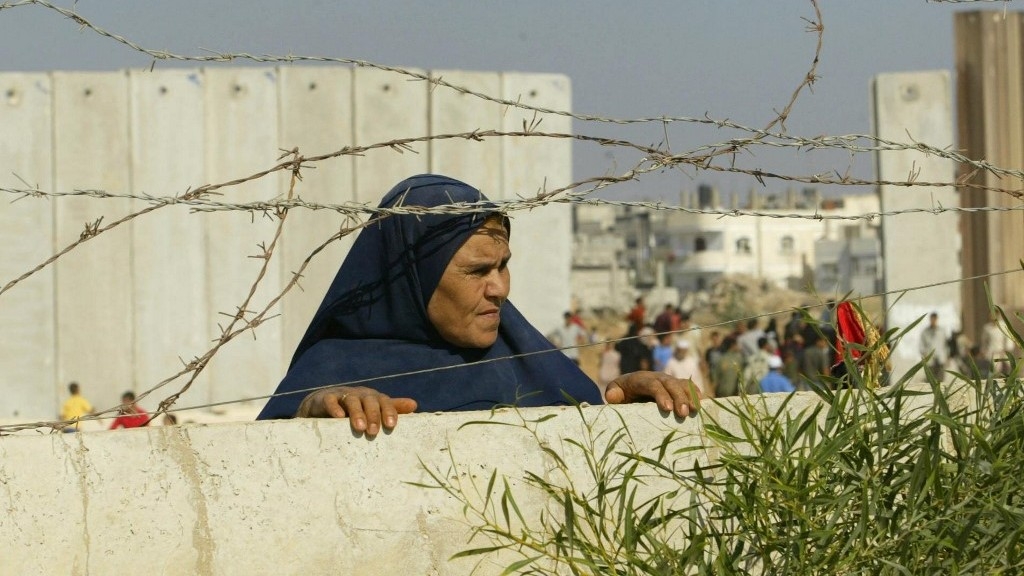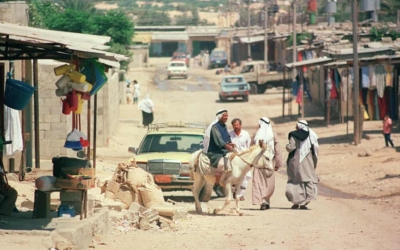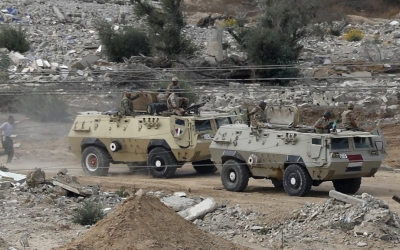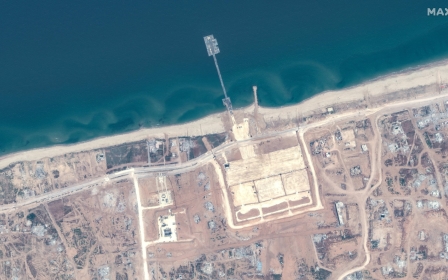
Rafah: The families torn by a city's split between Egypt and Gaza
As Israel violently took control of the Rafah crossing in Gaza, the only gateway between Palestine and Egypt, Abubakar* reflected on decades of strife on either side of the boundary.
The 67-year-old tribal judge, who lives in North Sinai, has lived through many violent Israeli incursions and invasions, as well as times of relative calm.
“In the past, movement was easy. The residents never felt like they were from two different countries or communities,” he told Middle East Eye.
“It wasn't until the division and the demarcation of the borders between Egypt and Gaza that two different identities emerged.”
That boundary was drawn in 1982, and meant that Rafah was one of a few cities in the world, like Nicosia and Jerusalem, that's divided across two different territories.
New MEE newsletter: Jerusalem Dispatch
Sign up to get the latest insights and analysis on Israel-Palestine, alongside Turkey Unpacked and other MEE newsletters
Both parts of the divided city face significant hardship.
In Egypt's Rafah, in the Sinai peninsula northeast of the country, authorities have razed the entire city to the ground, leaving its residents displaced and disillusioned.
On the Palestinian side, in southern Gaza, the people of Rafah - already under 17 years of Israeli-enforced blockade - have lived under daily Israeli bombs since 7 October.
Ground troops have launched a deadly invasion, seizing control of the Rafah crossing in May and forcibly ejecting up to one million (already displaced) Palestinians.
New border divides families
For millennia, the city and its hardships were felt as one entity.
But in March 1982, barbed wire fences carved Rafah in two, splitting up families and fracturing their sense of identity and belonging.
“We were in great shock,” said Ghassan*, a 60-year-old teacher from Rafah in southern Gaza, recalling the demarcation four decades ago.
“We could never have imagined that an Egyptian officer would stand alongside an Israeli officer in Rafah to draw borders.”
“Everyone was angry. We weren't even consulted about the division or asked for our opinion.”
Abubakar remembers the period vividly.
“The Israeli officers told us before they left [Egypt’s] Rafah and Arish that we could choose where we wanted to live. However, the residents didn't grasp the situation until the demarcation and placement of markers began,” he said.
Families were forced to make a quick decision on which side to settle. Most based it on the locations of their agricultural land, or their workplace.
“For example, a teacher working in Arish had to leave his job and move to Khan Younis because he had a house there, while other families relocated because they had a shop or business in one of the cities in North Sinai,” said Abubakar.
“It caused great confusion and a significant shock.”
Division under British-Ottoman rule
Rafah was not a newly divided city: it had first been demarcated along Egyptian and Palestinian lines in 1906.
Under pressure from the British, who were de facto rulers of Egypt at the time, the Ottomans drew a line between its sprawling empire and the Sinai peninsula, which cut through the city of Rafah.
For the first time in Rafah’s 3000-year history of habitation, it was divided between two territories.
Those borders, which were not precisely drawn, were maintained for decades: first under the British mandate of Palestine, and then during Egypt’s control of the Gaza Strip after the 1948 Nakba.
It was in 1967, following the Middle East war which saw Israel occupy the Sinai peninsula and Gaza, that the border came down.
Then, in October 1973, a surprise attack by Egyptian and Syrian forces led to full-scale conflict in Sinai and the occupied Golan Heights. Thousands of Syrians, Egyptians, Palestinians and Israelis were killed.
The end of the three-week war began a process of negotiations between Egypt and Israel, which ended in a peace treaty in 1979 and normalisation of diplomatic ties.
It also saw the Sinai peninsula return to Egyptian hands, and the redrawing of the border cutting through the two cities of Rafah, to divide Egypt and Israeli-occupied Gaza.
While the 1906 boundary was imprecise, the 1982 version was a hard border. It cut through streets, neighbourhoods and agricultural lands. It even split individual homes.
Mostafa*, 37, from Palestinian Rafah, was not alive during the border construction, but has spoken with his family about it.
“My father said no one knew their fate during the demarcation, whether their house would fall inside Egypt or Gaza.”
At the time, many Rafah residents wanted to be in Egypt. “They didn’t want to live under Israeli occupation,” Mostafa said.
Crossing tunnels to see family
Families were torn apart by the demarcation line, with many relatives going for years, or decades, without seeing each other again.
The Rafah crossing became the only official point of entry and exit between Egypt and Israeli-occupied Gaza. But there were many restrictions for ordinary Palestinians and Egyptians to using it.
To circumvent that, families began to build tunnels connecting Gaza to North Sinai. The first such tunnel was discovered by Israel as early as 1983.
To avoid detection from Israeli authorities, Palestinians in Rafah would build tunnels from the basements of their own homes, which would re-emerge in a relatives’ home or farmland in Egypt.
While some tunnels would later come to be used to export goods, and for the smuggling of weapons and contraband, many of them began as civilian tunnels for family reunions.
“I’ve crossed through the tunnels twice. One of the times was because I wanted to buy some gifts for my sister when she gave birth to her first child,” said Mostafa.
Ayman*, 23, on the Egyptian side, first used a tunnel at the age of ten.
“I remember that day well. It was on Eid al-Fitr, and it was the first time I saw my aunt and grandfather,” he said.
“At that time, my mother was afraid of tunnels and believed that the tunnel could collapse on us at any moment.
“It was a strange experience. Why should I have to enter a tunnel just to see my grandfather?”
For tribal judge Abubakar, crossing the tunnels became an important part of his job.
Based in Sinai, he would travel from Egypt to Palestine and back to adjudicate issues arising between families, anywhere from Arish to Gaza City.
“Crossing through the official border required time and bureaucratic procedures. So that led me to use the tunnels frequently to enter Gaza to mediate and judge between complaining families and individuals,” he said.
“On one occasion, I went to Gaza to resolve an issue between two families living in Palestinian Rafah. The dispute was over the division of inheritance.”
His religious knowledge and background made him a respected arbiter between complainants.
“Another time, I adjudicated between two traders who were smuggling their goods through the tunnels.”
Morsi eases division
Ghassan, 60, has never used a tunnel, but some of his cousins in Egypt visited him in Gaza in 2009 and 2010 using the underground passages.
He made the return journey to Sinai in 2012, using the Rafah crossing.
“I reunited with my sister for the first time since the demarcation. It was shortly after Morsi won the elections.”
'I reunited with my sister for the first time since the demarcation. It was shortly after Morsi won the elections'
- Ghassan, Palestinian teacher from Rafah
He was referring to the election of President Mohamed Morsi in June 2012, a year after the popular revolution that ousted long-time President Hosni Mubarak.
Morsi vowed to ease the siege on Gaza, and the Rafah crossing was opened more frequently for Palestinians during his rule.
It was to be short-lived. Morsi was overthrown in a coup by his defence minister Abdel Fattah el-Sisi, who has maintained an authoritarian grip on power since.
Since coming to power, Sisi has demolished almost the entirety of Egypt’s Rafah, displacing thousands of residents.
The president cited security reasons for the demolitions, following high-profile attacks by Sinai-based militants in the Peninsula.
Alongside that, Egyptian authorities destroyed more than 2,000 tunnels linking Sinai and Gaza between 2011 and 2015, again citing security concerns.
Almost all of the civilian tunnels linking people’s homes were destroyed, said Abubakar, who is no longer able to travel to Gaza to adjudicate disputes.
'I was Egyptian but became Palestinian'
The arbitrary demarcation, as well as Cairo’s treatment of Sinai inhabitants, has left many in Egyptian Rafah with confused identities.
As a child, Ayman would ask his mother whether the family were Egyptian or Palestinian.
“She would stand there, unable to give me a quick answer,” he said.
“She would respond: ‘We are Egyptians because we have Egyptian IDs, but we are also Palestinians because your uncle and grandfather are in Rafah inside Gaza’.”
Ayman felt certain that Egyptian authorities did not see him as one of their own.
“They considered us enemies or spies. That’s despite my uncle being killed during the 6 October War while gathering information for the Egyptian army about Israeli movements in Sinai.”
Five decades after that war, which saw thousands of Egyptians killed at the hands of Israeli troops, Israel is in the midst of its most deadly war on Gaza.
Some in Egypt’s Rafah feel let down by Cairo.
“Egypt now, under Sisi's administration, is in full cooperation with Israel, working for Israel's interests and not considering us or including us in its interests,” said Ayman.
Cairo has reportedly built a buffer zone in the event of possibly taking in thousands of Palestinian refugees displaced by Israel’s war. It’s an eventuality that Palestinians have described as a “second Nakba”.
'I was Egyptian during the 6 October war and became Palestinian after 7 October'
- Abubakar, tribal judge in North Sinai
Egyptian state-linked firms have also been accused of making up to $2m a day from charging Palestinians to cross the Rafah border. Those crossing have since stopped, after Israel seized control of the gateway in May.
Mostafa, in Gaza, said: “What Israel is doing is what it has been doing for a long time. But what Sisi is doing is unprecedented amongst previous Egyptian presidents.”
For Abubakar, who has Egyptian nationality, recent events mean he now considers himself Palestinian.
“I stand with anyone who fights against Israel. I was Egyptian during the 6 October war and became Palestinian after 7 October.”
*Names have been changed to protect the sources from government reprisals
Top image: A Palestinian woman stands while looking into Egypt along the Gaza-Egypt boundary on 12 September 2005 (AFP)
Middle East Eye delivers independent and unrivalled coverage and analysis of the Middle East, North Africa and beyond. To learn more about republishing this content and the associated fees, please fill out this form. More about MEE can be found here.









